A Historical Perspective on Choir Recording Techniques
Paul McGlashan, Sound Engineer, New Zealand
The last 100 years have seen huge changes in sound recording techniques and technology with distinct eras responsible for innovation at all aspects and stages of music production – from recording, engineering, and post-production through to music distribution, consumer channels and technology. Recording of acoustic ensembles such as choirs and orchestras sits within this landscape and whilst traditional approaches to recording are still prevalent today, the stage is set for a new era based on immersive recording and production techniques that are becoming increasingly mainstream for video, music and gaming industries.
The traditional approach to capturing a choral or orchestral performance typically relies on the acoustic qualities of the venue to obtain a balanced sound and a sense of realism. Ideally a venue is chosen to match the style of music and size of the ensemble. The recording engineer will choose an appropriate microphone configuration and positioning that captures an overall balance of the ensemble and a satisfying ratio of direct to reverberant sound. Choice of microphone (e.g. omni-directional vs. directional) and positioning also depends on factors such as the ambient noise level in the venue (air-conditioning, traffic, birds, weather), the degree and consistency of the choral ensemble, and the use of soloists and accompanying instruments.
Whilst there are a wide variety of microphone configurations, a typical setup for acapella choir is usually based on a matched stereo pair of microphones for capturing the overall sound stage, optionally supported by spot microphones for choir sections and soloists (depending on the venue acoustics and the quality of the solo singers). The stereo microphone technique used is typically a spaced or near-coincident pair (e.g., omni-directional mics in Small AB, or directional mics in ORTF or NOS) perhaps supported by outrigger omni-directional or wide-cardioid microphones for large choirs. These choices usually result in the best sense of envelopment and spaciousness. The spot mics are tastefully blended to ensure that the overall balance and positioning of the soloists within the sound stage is as authentic as possible. The microphones are fed to an audio recorder ideally via a high quality, minimalist recording chain and the recording subsequently post-produced (edited, mixed, mastered). Outside of editing and mixing, manipulation of the recorded sound (e.g., equalisation, compression) is usually kept to a minimum or not used at all. However additional reverberation may be added during post-production to glue the performance together and improve the sense of envelopment (a feeling of being surrounded by sound).
Today stereo recordings are still the predominant means of capturing choral performances. The microphone techniques and considerations used for choir or orchestra recordings haven’t changed fundamentally since the early days of stereo recording back in the mid-1950s, when the introduction of magnetic tape drove much innovation in stereo recording.
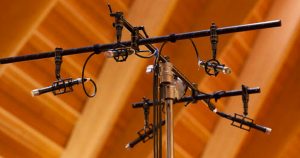
The move from tape to digital in the 1970s led to further improvements in audio quality and innovation in the recording and playback of multi-channel sound. New surround microphone techniques captured sound from the front but also from the sides and rear in an effort to capture a 360-degree perspective. These recording techniques were coupled with playback formats such as Quadrophonic in the 1970’s and Dolby 5.1 and DTS in the 1980s and 1990s. The aim of surround was to produce a more convincing sense of envelopment than you could get with stereo. However, like stereo where the sound stage is perceived to be in front of the listener, surround was only partially successful at producing a 360-degree experience since the impression was still of a largely 2-dimensional or horizontal sound stage.

Binaural techniques progressed further during the 1970s with the use of a dummy human head with microphones located in the ears to simulate the way in which human beings perceive sound. Our ability to localise sound comes from sound arriving at our ears at slightly different times and levels. These inter-aural differences are largely governed by the shape of our heads, the distance between the ears, and their size and shape. The result is an accurate 3-dimensional sound stage with the listener in the centre and the sound appearing not just from left and right (as with traditional stereo) but also from below, above and behind. Binaural recordings are best played back on headphones and depending on the where the dummy head is positioned can give an uncanny feeling of “being there” in the room with the performers. To date binaural has been a niche in the music recording scene and whilst it has been used to good effect by some contemporary artists, it hasn’t been that popular for choral and orchestral recordings. (see CD Review in ICB 2021-3) However, this is changing as headphones increasingly become the primary way of listening to music, with the growing trends in spatial recordings and as low-cost binaural head technology becomes available.
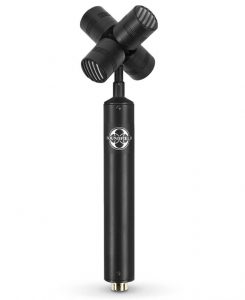
Ambisonics, a technique developed in the 1970s, captures a 3-dimensional impression using a tetrahedral arrangement of four microphones located at a single point in space and has been a popular approach to surround recording for both music and film. An interesting property of this technique is that the recordings can be manipulated in post-production. Various microphone patterns can be emulated by decoding the signals from the four microphones in different ways. This is great for reproducing the soundscape of a crowd or a city, although to experience this fully on speakers you must be seated in the “sweet spot.” When rendered to binaural format for headphone playback, Ambisonics provides very convincing immersive experiences. Ambisonics too has been a niche player in the world of acoustic ensemble recording – a key reason being that whilst it can provide a realistic soundstage the lack of low-frequency response from the directional microphones used means the sense of envelopment is not as convincing as stereo and surround techniques that use omni-directional microphones.
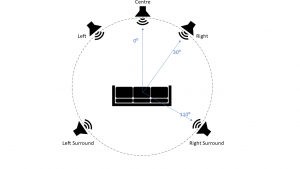
As with stereo, recording and mixing a choir for surround typically involves panning the left and right main microphones to the left and right speakers to provide the foundation of the front sound stage. A centre main microphone (if used) is panned to the centre speaker and the left and right rear facing microphones panned to the left and right surrounds respectively. Mixing levels are then adjusted to achieve the appropriate left-to-right and front-to-back balance. The left and right surrounds provide a diffuse reverberant sound and assist with the sense of envelopment by emulating the venue reflections coming from behind the listener. Spot mics are panned as appropriate typically within the left to right front-facing sound stage – but could be panned to the sides or surrounds for interesting effects e.g., soloists in the gallery, the sides of the venue. Artificial reverberation may be required to meld soloists into the soundstage and a surround reverb may be added as overall glue and to enhance the sense of spaciousness. There is no doubt that surround can provide a step up from stereo in terms of realism and sense of envelopment. However, due to surround’s reliance on fairly costly mutli-channel speaker-based systems, its popularity has been limited and the additional production costs not easily justified.
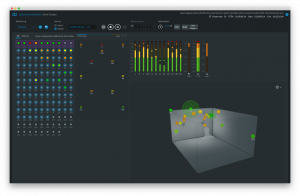
Today the goal of envelopment has progressed beyond the original ambitions of surround sound and has led to a new era of immersive 3-dimensional audio. Whereas surround formats create a sound stage that surrounds the listener, the sound still arrives at the ears in the horizontal plane with speakers positioned in front, beside and behind the listening position. These surround formats ignore the fact that in a real performance much of the sound also comes at you from above, e.g., ceiling and balcony reflections. It is this additional height dimension that is the secret sauce for contemporary immersive sound formats such as Dolby Atmos, DTS:X and Auro-3D which add additional speakers located above the listener to provide the height information. Binaural too has become more mainstream with the increasing popularity of headphones and the ability of the immersive sound formats to fold-down a multi-channel recording to a binaural version for immersive headphone listening. This has allowed immersive formats (Dolby Atmos in particular) to move beyond the speaker-based constraints of the cinema and living room to personal playback devices with access to streaming platforms such as Apple Music, Amazon Music and Tidal which are increasingly offering immersive content.
Recent advances in immersive formats have opened a new world of music production possibilities and the creation of experiences based on virtual acoustics. Not only is it possible to pan microphones in the traditional way in two dimensions but with the additional height speakers the sound mixer has a 3-dimensional space to play with allowing for mixes with a much more open and less cluttered feel. It is now possible to go beyond channel-based panning techniques by using “objects”. Object-based approaches allow you to assign your microphones (and other sound sources) to an object and to position (pan) it anywhere within a 360-degree virtual space around the listener. Panning automation allows these objects to be moved independently within the sound stage and a path defined for steering an object around the listener – great for movie sound effects (planes flying overhead or arrows whizzing past your ears).
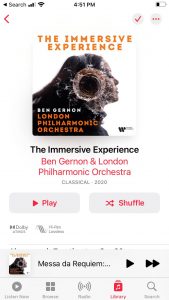
Immersive, object-based formats open up new opportunities for choir recordings. Imagine each choir member having their own microphone and in post-production being able to manipulate each singer as an independent object – locating them at different positions around the listener. It would be possible to create completely different listening experiences and musical effects. An opportunity perhaps for innovative treatment of choral works like Eric Whitacre’s “Leonardo Dreams of his Flying Machine”.
It is still early days for immersive music and whilst there is a growing amount of immersive content much of this is remixes of stereo recordings. As a result, there are few examples of choral or orchestral performances that have been specifically recorded with an immersive format in mind. That said one great example is available on Apple Music in Decca’s Immersive Experience which includes a magnificent rendition of the introduction to the Dies Irae from Verdi’s Requiem. Performed by the London Philharmonic Choir and Orchestra the sense of “being there” in the midst of the orchestra and choir is pretty compelling – resulting in a much more intimate engagement with the performance than you would get from a typical stereo version. To listen to this of course you need to play it back through a device capable of rendering Dolby Atmos – easily done with headphones on an Apple iPhone and ensuring the Music app’s “Dolby Atmos” setting is set to “Always On”.
Whilst stereo recording and playback will continue to be the mainstay of acoustic recording for the foreseeable future, a new era of innovation with immersive sound has begun. Object-based immersive formats such as Dolby Atmos will enable innovative sound design and new perspectives for the music listener – able to experience a performance, say, from the perspective of a choir member or section, the conductor or an audience member. The possibilities are endless! At the end of the day however, the immersive audio is still just a simulation of reality, and in my book whilst this listening experience has its place there is still nothing like physically being part of a real performance – as a choir singer or an audience member. I still vividly remember being in the tenor section of the Verdi Requiem about 20 years ago, standing behind and not far from the orchestra percussion section and being overwhelmed by the visceral punch to my chest from the shockwave of the two bass drums as they whacked those massive hits in the intro. Now that was really “being there!”
 PAUL MCGLASHAN is the owner and recording engineer for Classic Sound, a boutique recording company based on Great Barrier Island, Auckland, New Zealand that specialises in the recording and post-production of classical and acoustic music. Over the last 20 years Paul has engineered orchestral, ensemble and choral recordings for most of the major orchestras, chamber ensembles and choirs in New Zealand, often in collaboration with Atoll records. Early in his career Paul gained experience with a range of local and overseas classical performances during a three-year part-time internship at Radio New Zealand Concert. Paul was also responsible for recording and mixing the music for the opening ceremony of the 2011 Rugby World Cup which was broadcast to a world-wide TV audience. Paul has 1st class honours masters degrees in Computer Science and Creative and Performing Arts from Auckland University. He is a classically trained musician (voice) and was a member of the widely acclaimed Viva Voce chamber choir for 20 years before leaving to live on Great Barrier in 2016.
PAUL MCGLASHAN is the owner and recording engineer for Classic Sound, a boutique recording company based on Great Barrier Island, Auckland, New Zealand that specialises in the recording and post-production of classical and acoustic music. Over the last 20 years Paul has engineered orchestral, ensemble and choral recordings for most of the major orchestras, chamber ensembles and choirs in New Zealand, often in collaboration with Atoll records. Early in his career Paul gained experience with a range of local and overseas classical performances during a three-year part-time internship at Radio New Zealand Concert. Paul was also responsible for recording and mixing the music for the opening ceremony of the 2011 Rugby World Cup which was broadcast to a world-wide TV audience. Paul has 1st class honours masters degrees in Computer Science and Creative and Performing Arts from Auckland University. He is a classically trained musician (voice) and was a member of the widely acclaimed Viva Voce chamber choir for 20 years before leaving to live on Great Barrier in 2016.
Edited by Taylor Ffitch, USA
